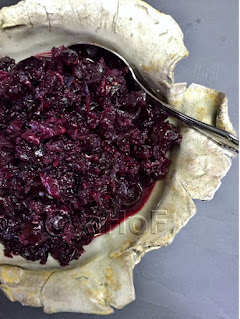 |
| Fermented Red Cabbage Kraut with Beet |
Not too long ago I started a red cabbage ferment with some red beet grated in. I do not like raw beets. I absolutely love cooked beets, just about any way. Making this red kraut, which I hoped to enhance color-wise with the beet, was a total experiment. This time it was a tremendously successful experiment. I cannot taste the beet at all, and the color is lovely. The overall flavor is far better than the green cabbage kraut. I just love it!
 |
| Fermented Red Cabbage Kraut with Beet |
Red Cabbage Kraut with Beet
 |
| Fermented Red Cabbage Kraut with Beet |
1½ pounds red cabbage, finely shredded
1 beet, about 5.5 ounces, peeled and shredded
2 cups baby arugula leaves
1 large red onion, cut in thin slivers
2 red Fresno chilies, sliced
2 cloves fresh garlic, minced
1 teaspoon dried hibiscus flower tea
¼ cup liquid from a previous ferment, as a starter
1 teaspoon juniper berries
½ teaspoon allspice berries
4 - 5 teaspoons coarse sea salt
2 - 4 cabbage leaves for covering the final mixture
BRINE, if needed:
1½ teaspoons coarse sea salt, dissolved in:
1 cup water
Place all the ingredients into a very large bowl with the salt. Use hands to squeeze the mixture or some implement to smash down the mixture and break down the cell walls of the vegetables (such as a meat tenderizer or a heavy rolling pin). The goal is to break down the vegetables enough so that the overall size and amount shrinks to about half the original bulk. This can be done in short bursts, allowing the mixture to rest for an hour in between and form its juices. It is preferable to have the cabbage make its own juice, but if there is not enough juice to cover the mixture when the vegetables are pressed down, then the added brine may be needed.
Pack the mixture into one very large or two smaller bail-wire jars (Fido) fitted with an airlock. Allow about ⅓ empty jar space above the vegetables. Press the mixture into the jars very tightly, ensuring that the juices completely cover the vegetables. Cover with the reserved cabbage leaves and weight the vegetables with glass weights or zip-top baggies of water. The goal is to keep everything submerged. Close the lid and have the airlock in place. Set the jar in a dark corner to ferment for 2 to 4 weeks. This time will depend on how warm or cool the room temperature is. Cooler will take longer fermenting time. Warmer will ferment more rapidly.
Once fermented to your taste (or when all bubbling stops), re-pack the ferment into jars with a plastic lid and refrigerate.
My passion is teaching people how to create a harmony of flavors with their cooking, and passing along my love and joy of food, both simple or exotic, plain or fancy. I continue my journey in ethnic and domestic cuisines, continuing my journey to explore diverse culinary experiences and hopefully to start you on a journey of your own. Join me also at A Harmony of Flavors on Facebook, and Pinterest.











